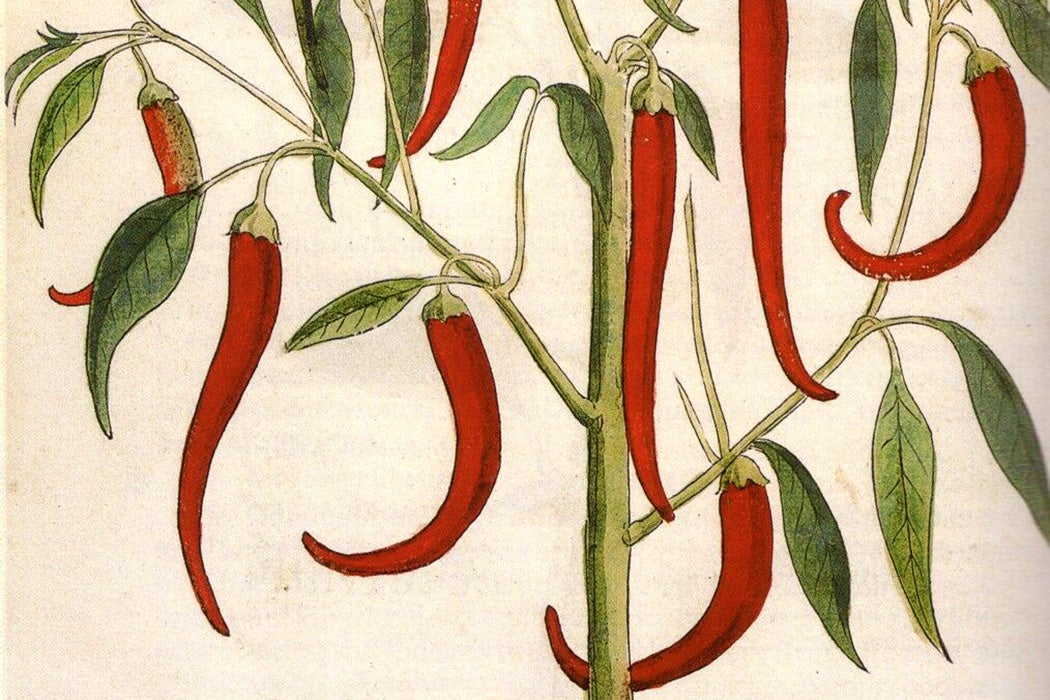Trying to spice up your quarantine food with chili peppers? You might be interested in their place in world culture and history.
Not all chilis are hot. Some are mildly sweet, others comfortably warming. Used in widely different cuisines on every continent, chilis originated in the Western Hemisphere. “Chili” itself comes from a Nahuatl word.
There’s a great variety of chili peppers, but all of them stem from just five domesticated species in the genus Capsicum, a member of the same nightshade family as tomatoes, potatoes, and tobacco.
Capsicum annuum may be the most familiar chili to Americans because it is the source of the bell pepper. Bells aren’t hot at all because they are one of the few chili varieties that lack capsaicin, the chemical that produces the burning sensation found in hotter varieties. The mild bell, named for its shape, was first cultivated only about ninety years ago. They come in all shades of the rainbow, but green is most common. (The green ones are actually just unripened versions of the red ones.)
But don’t get the idea that all the varieties that come from Capsicum annuum are sweetly harmless. Cayenne, jalapeño, and the varieties known as “New Mexico chili” are also C. annuum cultivars. Capsicum annuum was first domesticated in Mexico. The fascinating archeological, ecological, genetic, and paleobiolinguistic evidence pointing to this origin are explored here.
So while most of the world has had a mere half millennium’s experience with chilis, Mexico’s relationship with this “ancient fruit” goes back around 9,000 years. Initially, those would have been wild chilis. But even by the time Spanish invaders arrived, chilis had been domesticated for thousands of years. The Spaniards found peoples with millennia of chili knowledge, and chilis of multiple colors, shapes, and levels of spiciness. Spanish chroniclers wrote of
merchants who specialized in importing chilies from remote regions; cooks and street vendors—usually women—who prepared and sold spicy dishes and tortillas, or tortillas stuffed with withe meat and ground chili. These delicious-sounding snacks were quite possibly the predecessors of today’s tacos, sopas, and gorditas.
Chilis were so central to the pre-Hispanic diet that “one of the main forms of religious fasting was avoiding salt and chilies,” write José Francisco Román Gutiérrez and Leticia Ivonne Del Río Hernández.
Besides their spicy flavor, chilies enhanced food preparations with sweet, bitter or tart nuances, adding sharp or more subtle contrasts. When combined with meat and vegetables, they provided endless possibilities in the broad spectrum of indigenous cookery.
In their discussion of the “pungency of Mexico’s pre-Hispanic past,” Román Gutiérrez and Del Rio Hernández explain that, in addition to food, native Mexicans used chilis as tribute, in rituals, and as medicine.
Weekly Newsletter
Chilis could also be weaponized, to discipline children, torture captives, and punish losers in competitions. Capsaicin can burn in more than one way. Refractory children would have the smoke of burning chilis wafted towards them. Losers of bets might have chilis rubbed into the skin and eyes.
But we were talking food: Román Gutiérrez and Del Rio Hernández note that an ancestor of mole, the now traditional sauce/marinade, was called chilmolli. As its name suggests, chilis played a prominent part in this sauce.
Support JSTOR Daily! Join our new membership program on Patreon today.







